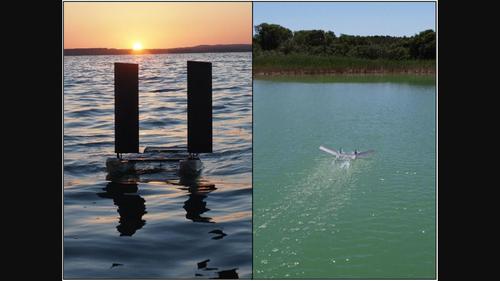Use of an unmanned aerial-aquatic vehicle for acoustic sensing in freshwater ecosystems
IF 4.3
2区 环境科学与生态学
Q1 ECOLOGY
引用次数: 0
Abstract
Freshwater ecosystems are endangered, underfunded and understudied, making new methods such as passive acoustic monitoring (PAM) essential for improving the efficiency and effectiveness of data collection. However, many challenges are still to be addressed with PAM: difficulty in accessing research sites, the logistics of implementing large-scale studies and the invasiveness of data collection. When combined with PAM and other sensing strategies, mobile robotics are a promising solution to directly address these challenges. In this paper, we integrate water surface and underwater acoustic monitoring equipment onto a prototype unmanned aerial-aquatic vehicle (UAAV) capable of sailing and flight (SailMAV). Twelve autonomous sailing missions were run on Lake Vrana, Croatia, during which acoustic data were collected, and the ability of the UAAV to facilitate the collection of acoustic data demonstrated. Data were simultaneously collected using standard recording methods on buoys and banksides to provide a comparative approach. Acoustic indices were used to analyse the soundscape of underwater acoustic data and BirdNET (a deep artificial neural network) was used on water surface datasets to determine bird species composition. Results show higher species richness and call abundance from UAAV surveys and high site dissimilarity owing to turnover between stationary and UAAV methods. This highlights the success of the UAAV in detecting biodiversity and the complementarity of these methods in providing a broad picture of the biodiversity of freshwater ecosystems. Increased bird diversity and underwater acoustic activity in protected areas demonstrate the benefits of protecting freshwater ecosystems; however, site dissimilarity driven by turnover highlights the importance of protecting the entire ecosystem. We show how, by integrating PAM and a UAAV, we can overcome some of the current challenges in freshwater biodiversity monitoring, improving accessibility, increasing spatial scale and coverage, and reducing invasiveness.

利用无人驾驶航空水上飞行器在淡水生态系统中进行声学传感
淡水生态系统濒临灭绝,资金不足,研究不够,因此,被动声学监测(PAM)等新方法对于提高数据收集的效率和效果至关重要。然而,被动声学监测仍面临许多挑战:难以进入研究地点、实施大规模研究的后勤问题以及数据收集的侵入性。如果将 PAM 与其他传感策略相结合,移动机器人将是直接应对这些挑战的一个很有前途的解决方案。在本文中,我们将水面和水下声学监测设备集成到能够航行和飞行的无人驾驶航空水上飞行器(UAAV)原型上(SailMAV)。在克罗地亚弗拉纳湖执行了 12 次自主航行任务,期间收集了声学数据,并展示了 UAAV 促进声学数据收集的能力。同时使用浮标和岸边的标准记录方法收集数据,以提供一种比较方法。声学指数用于分析水下声学数据的声景,BirdNET(深度人工神经网络)用于水面数据集,以确定鸟类物种组成。结果表明,UAAV 调查的物种丰富度和鸣叫丰度更高,而固定方法和 UAAV 方法之间的更替造成的地点差异很大。这凸显了 UAAV 在探测生物多样性方面的成功,以及这些方法在提供淡水生态系统生物多样性全貌方面的互补性。保护区内鸟类多样性和水下声学活动的增加表明了保护淡水生态系统的益处;然而,更替导致的地点差异突出了保护整个生态系统的重要性。我们展示了如何通过整合 PAM 和 UAAV 来克服当前淡水生物多样性监测中的一些挑战,改善可及性、扩大空间范围和覆盖面并减少入侵。
本文章由计算机程序翻译,如有差异,请以英文原文为准。
求助全文
约1分钟内获得全文
求助全文
来源期刊

Remote Sensing in Ecology and Conservation
Earth and Planetary Sciences-Computers in Earth Sciences
CiteScore
9.80
自引率
5.50%
发文量
69
审稿时长
18 weeks
期刊介绍:
emote Sensing in Ecology and Conservation provides a forum for rapid, peer-reviewed publication of novel, multidisciplinary research at the interface between remote sensing science and ecology and conservation. The journal prioritizes findings that advance the scientific basis of ecology and conservation, promoting the development of remote-sensing based methods relevant to the management of land use and biological systems at all levels, from populations and species to ecosystems and biomes. The journal defines remote sensing in its broadest sense, including data acquisition by hand-held and fixed ground-based sensors, such as camera traps and acoustic recorders, and sensors on airplanes and satellites. The intended journal’s audience includes ecologists, conservation scientists, policy makers, managers of terrestrial and aquatic systems, remote sensing scientists, and students.
Remote Sensing in Ecology and Conservation is a fully open access journal from Wiley and the Zoological Society of London. Remote sensing has enormous potential as to provide information on the state of, and pressures on, biological diversity and ecosystem services, at multiple spatial and temporal scales. This new publication provides a forum for multidisciplinary research in remote sensing science, ecological research and conservation science.
 求助内容:
求助内容: 应助结果提醒方式:
应助结果提醒方式:


